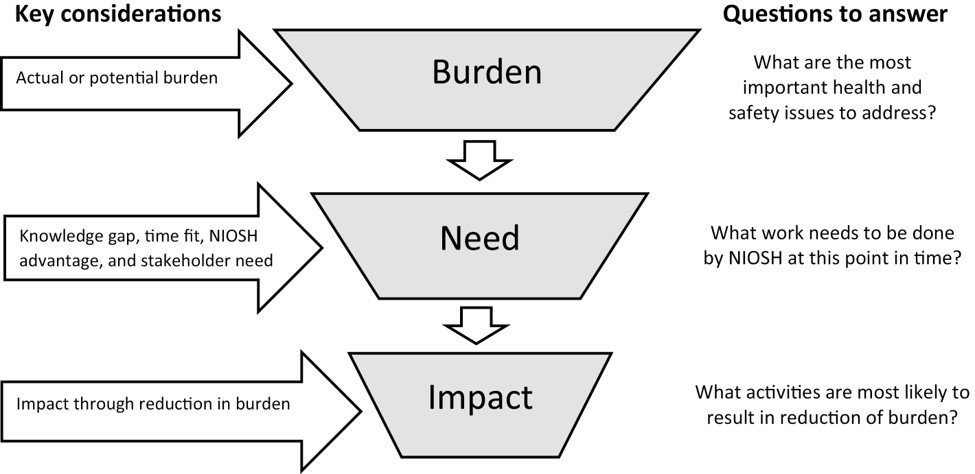Burden, Need and Impact: An Evidence-Based Method to Identify Worker Safety and Health Research Priorities
Posted on byThe National Institute for Occupational Safety and Health (NIOSH), like all federal agencies, must ensure a thoughtful investment of public funds in fulfilling its statutory mandate. As public funding for science research programs becomes more constrained, and the demand for increased accountability of government spending grows, the need to demonstrate the impact or return on taxpayers’ investment becomes a necessity for research agencies. NIOSH has developed an evidence-based method that uses the criteria of ‘burden’, ‘need’, and ‘impact’ to identify research priorities. This method is explained in detail in the article “Burden, Need and Impact: An Evidence-Based Method to Identify Worker Safety and Health Research Priorities” published in the May issue of Annals of Work Exposures and Health. The NIOSH approach, named the BNI method, may be useful to other public and private sector research agencies or entities that need a systematic way to set research priorities and allocate increasingly scarce resources for research while ensuring the maximal return on investment.
Estimates of the societal cost of work-related fatalities, injuries, and illnesses range up to $2.2 trillion in the U.S. from 2007 to 2015, which may be an underestimate of total societal costs. The BNI method is an evidence-based approach to setting research priorities and aligning investment with research that has the greatest likelihood of significant impact to reduce the burden of worker injury and illness. This method addresses the changing nature of work, the workforce, and the workplace and provides decision criteria that are more solution oriented than observational resulting in interventions that can be readily applied to new occupational hazards and exposures.
NIOSH has utilized other priority setting initiatives throughout the years, namely the last three decades of the National Occupational Research Agenda (NORA). However, this paper represents the first time NIOSH has formalized a method for deciding important research allocation questions. NIOSH is using the BNI method within the framework of the sector and cross-sector program structure of NORA 3 to align research priorities and funding in a systematic and transparent manner. Fig. 1 depicts the BNI method by which priority research goals are developed. Burden (actual or potential) identifies the most important health and safety issues to address by considering the evidence of exposure/hazard, injury/illness, disability/severity, and cost. Need provides evidence of the knowledge gap that needs to be addressed, consideration of the most appropriate methodological approach to address the need, the time fit for conducting that research at this point in time, the particular advantage NIOSH has to do the work, and the explicit stakeholder need. Impact identifies research with the greatest likelihood of reducing burden, potential for results to be used or disseminated by others, and the likelihood the research will generate knowledge that leads to follow-on research.
Figure 1 BNI Method

The BNI method is an explicit, evidence-based conceptualization that allows NIOSH to distinguish among many priorities those that it will focus on the most. Ultimately, it allows NIOSH to ensure that its use of public funds for research addresses important occupational safety and health problems and reflects a thoughtful investment of public funds in fulfilling statutory mandate. The health and safety of workers and their productivity is a major determinant of the economic vitality of the Nation. BNI helps NIOSH contribute to improved worker health, safety, and well-being and, in doing so, contributes to securing the national interests.
Please post any questions about the BNI method in the comment section below. To find out more about BNI feel free to contact Sarah Felknor at sbf5@cdc.gov.
Sarah A. Felknor, MS, DrPH, is the Associate Director for Research Integration at NIOSH.
Paul A. Schulte, PhD, is Director of the NIOSH Education and Information Division.
Teresa Schnorr, Ph.D., is the Director of the NIOSH Division of Surveillance, Hazard Evaluations, and Field Studies and the manager of the NORA Services Sector Council.
Regina Pana-Cryan, PhD, is the Director of the Economic Research and Support Office in the NIOSH Office of the Director and a Co-Manager of the Healthy Work Design and Well-being Cross-Sector.
John Howard, MD, is the Director of the National Institute for Occupational Safety and Health.
Posted on by

